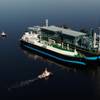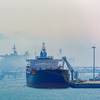Five Minutes with Kevin Lord, Chet Morrison Contractors
Manager of Subsea Operations, Chet Morrison Contractors
In conjunction with the Underwater Intervention exhibition MTR set forth to find an excellent source to speak in the first person on the diving industry, and more specifically the balance today between deploying man and machine. Kevin Lord is the Subsea Operations Manager within the Marine Construction Division of Chet Morrison Contractors. He began his commercial diving career in the Gulf of Mexico after serving four years in the United States Navy. In his 20 years in the industry, he has worked as a diver in both surface and saturation modes, as a diving supervisor, a project superintendent, project manager, and Operations manager. He has experience in both diving and deepwater projects, and has managed both diving and ROV divisions. Kevin currently serves as an executive board member on the U.S. Gulf of Mexico Diving Safety Work Group (DSWG).
Please tell us a bit about your role as the Manager of Subsea Operations at Chet Morrison Contractors.
As the Subsea Operations Manager, I’m responsible for overseeing the day-to-day operations and projects within the division. We have a group of very knowledgeable and talented individuals that make up an extraordinary team that I’m proud to be a part of. At Chet Morrison Contractors we pride ourselves on our safe work culture, good communications, and continual improvement through training and auditing. I enjoy interacting with our employees and our clients, as I owe our success to both.
Specifically, can you provide our readers background on your experience using ROVs and AUVs?
My experience is primarily in ROVs. I’ve worked with ROVs on many occasions, including several deepwater projects where divers are not an option. Even on shallower projects that I’ve managed, ROVs were used to inspect pipelines and platforms. For example, they’re a great tool after a hurricane for inspecting downed structures in order to get an initial survey for planning purposes.
Some specific ROVs I’ve worked with:
• TXL Work Class ROV – Hydraulic
o 100 HP, capable of working to depths of 2500 m
o Rugged, durable ROV with proven dependability
o Worked well in construction when outfitted with
2 manipulators
o I specifically remember it had the Schilling T3 and the Perry Slingsby 5 function
• TXLS Work Class ROV – Hydraulic
o 150 HP, capable of depths to 4000 m
o Excellent ROV for heavy construction
o The manipulators I remember were the Schilling
T4 7 function and a Schilling 5 function Rig Master
• Quest Electric Work Class ROV
o Equivalent to a 100 HP hydraulic ROV
o An environmentally friendly choice with an
all-electric propulsion system
o Manipulators on the this specific ROV were the Schilling Orion seven function and Schilling five function Rig Master
o Very quiet ROV around divers (heard often from divers; one guy said he wanted to put a cow bell on it so he knew it was around)
Also, I managed the installation of steel flow line jumpers in deepwater (approximately 7000 feet) using 2 ROV’s (Mississippi Canyon). On this project, we determined that the value of a second ROV for redundancy and for the extra set of eyes/manipulators on location far outweighed the daily cost and the mobilization. The client agreed and the project was successful.
On another project, we were closing spools for the oil and gas export lines on two different spar platforms (Green Canyon and Alaminos Canyon) at approximately 500 feet using divers with ROV support. These two spar projects required a lot of rigging that was attached to the heave plate to allow the spools to be set in place. The ROVs assisted divers in inspecting the heave plates, installing crossover lines, positioning rigging, and deploying tools. The ROV was able to ensure that spools lowered from the surface were stopped at correct elevation, allowing the diver to stay in the safe zone during the lowering phase. The ROV was a valuable tool for interacting with divers on these projects.
Obviously there are pros and cons to using man or machine to work safely and efficiently under the water. From where you sit, what are the major “Pros” of incorporating ROVs/AUVs? What are some of the “Cons”?
There are numerous “pros” to having an ROV support a diving operation, including: Having an extra set of eyes; Great lighting; You can attach hydraulic tools to ROV for diver use, such as impacts and grinders; to watch critical items, such as jumpers or spools, from the water interface to work site; and to increase productivity.
All the “pros” can turn to “cons” if a Simultaneous Operations (SimOps) plan is not developed and followed. A SimOps plan will identify risks and must clearly define procedures and establish the communication required to perform diving and ROV work simultaneously.
No special training is required to work with ROVs but at Chet Morrison we do develop Project Risk Assessments to identify and mitigate the risks. Divers are made aware of all the risks through this document at the project kick-off meeting and during the course of the project with the JSA.
It’s also important that divers and other personnel have clear communications and understand the chain of command. Both the ROV operator and the Diving Supervisor must have view of the ROV camera feed as well as the diver’s camera feed, so they can communicate effectively. But it’s crucial to understand that the Diving Supervisor is the final authority on the project while the diver is in the water and is responsible for ensuring the safety of all involved.
Removing divers from the water is a hot button topic for many people: As a diving company that deploys humans and underwater robots, how do you balance?
Getting divers to understand that ROVs are not going to take their job is the first step. Having a wide range of capabilities is what keeps companies a step ahead of competitors in a tough market, and at Chet Morrison Contractors we pride ourselves on our comprehensive approach to subsea work. Continuing to incorporate ROVs into our fleet on a regular basis allows us to grow as a company and will provide everyone, ROV operators and divers alike, with more work. An ROV can’t operate without someone knowledgeable and capable at its controls. A diver requires a knowledgeable supervisor and a capable topside support crew to be successful. ROVs and divers have a lot more in common than one would initially think; they’re part of a total team effort.
We get many different stories from many different views on the evolution of the capabilities of ROVs and AUVs. From where you sit, in you scope of experience, please describe how you see ROVs and AUVs have evolved in the past 5 to 10 years as far as their capability to conduct a given job effectively and efficiently.
As the technology advances in the deepwater markets, the ROVs are advancing with it. As operators continue to develop deepwater subsea fields, they are looking for ROVs to be outfitted with tools customized and developed for their exact needs. It’s fascinating to see the advancements made in recent years and I look forward to seeing how the industry continues to evolve in response to technological innovations.
As for the future of ROVs and divers, I definitely don’t see ROVs replacing divers—in shallow waters anyway—in the near future. Subsea work environments with low visibility where a sense of touch is required will continue to be better suited to divers, even with advancements in cameras and sonar. I do, however, see fewer divers doing work in depths of 500 feet or more, at least not when ROVs can do the same work without the need for decompression. Overall, I think we’ll see more integration and cooperation between ROVs and divers, which will ultimately contribute to making commercial diving a safer industry.
(As published in the November/December 2012 edition of Marine Technology Reporter - www.marinetechnologiesnews.com)












